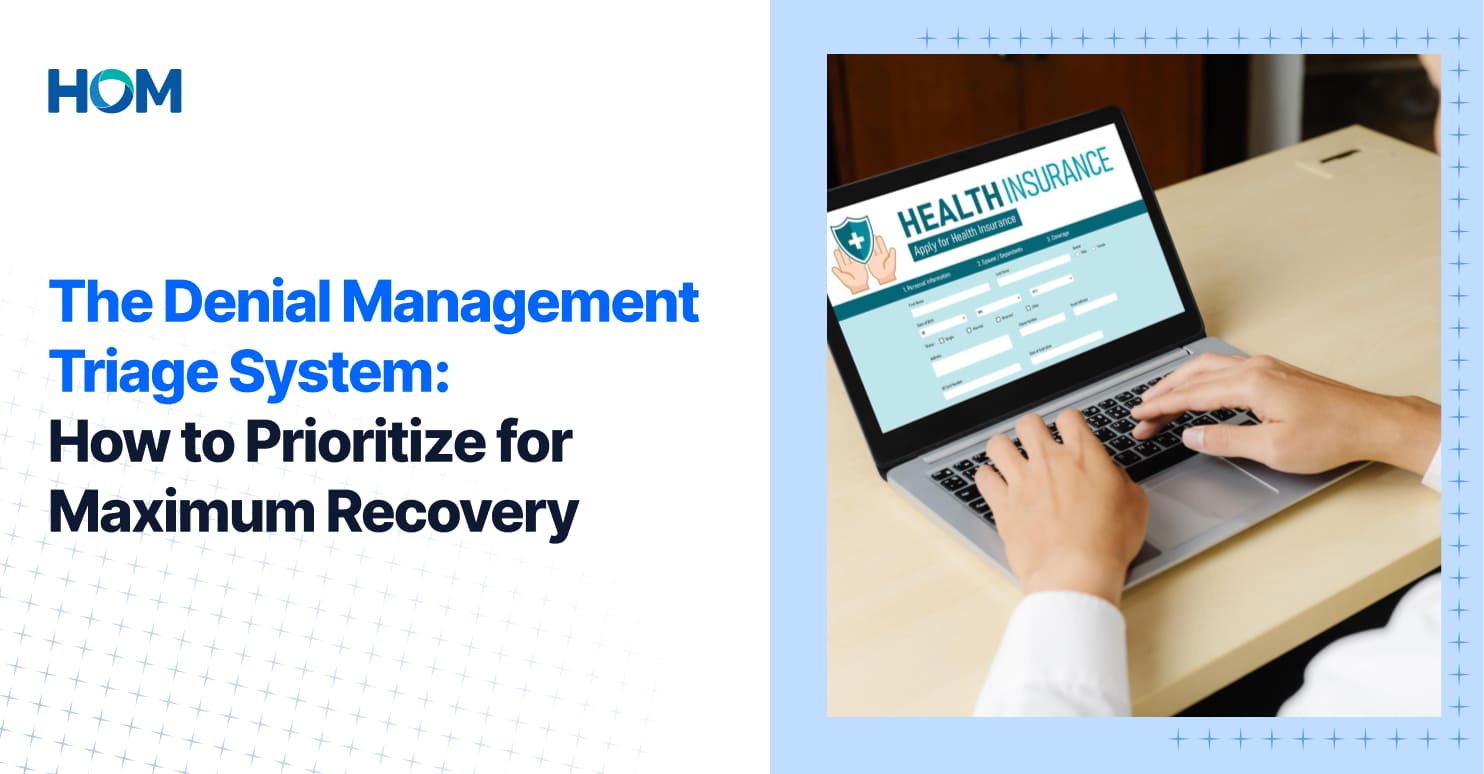
Utilization management is designed to make sure patients receive necessary, evidence-based care. In practice, however, it often creates delays and unintended harm. According to the 2024 American Medical Association survey, 93% of physicians reported prior authorization delays patient care, while in another survey, one in four reported serious adverse outcomes, including permanent impairment or even death. The financial strain is just as concerning – a recent survey found that nearly 15% of medical claims submitted to private payers are initially denied. When these denials combine with gaps in CDI and medical coding, the burden on healthcare organizations compounds, which affects both patient outcomes and revenue integrity.
As a trusted partner to healthcare payers and professionals worldwide, HOM has spent nearly eight years converting systemic issues in utilization management into competitive advantages through AI-forward revenue cycle management services.
This blog will discuss the biggest challenges in utilization management and how partnering with experienced RCM providers, like HOM, can help achieve sustainable revenue performance.
6 Critical Utilization Management Challenges Healthcare is Likely Facing
Healthcare organizations face many utilization management problems day-to-day, which directly impact their financial stability and patient care outcomes.
However, these six challenges need immediate attention and strategic solutions to prevent long-term financial damage:
1. Complicated Payer Policies
Every payer follows its own rules and review criteria for utilization management. Prior authorization processes, coverage policies, and documentation requirements vary significantly across patient populations and rarely look the same across payers.
Organizations face the daunting task of keeping up with hundreds of guidelines across state, commercial, and private Medicare plans while handling thousands of cases each month. Instead of focusing on care delivery, staff spend more time researching guidelines. The result is inefficiency, delays, and rising administrative costs.
2. Rising Payment Denials and Revenue Loss
Denials are one of the biggest pain points tied to utilization management. A 2024 Experian Health survey showed that 73% of healthcare providers are seeing more denials across payers, and 38% said at least one in ten claims gets rejected. For some organizations, the denial rate exceeds 15%.
Whether it’s errors in medical coding, missing documentation, or incomplete authorization, the revenue cycle suffers with each denied claim. They also consume additional resources for appeals, resubmissions, and follow-ups, making the true cost of poor UM practices far greater than it seems.
3. Inadequate Real-Time Decision Support Systems
When staff submit authorization requests, they often lack immediate access to evidence-based criteria.
Without advanced technology or integrated systems, decisions are made in the dark, leading to unnecessary delays or outright denials.
Most organizations discover problematic patterns only after claims are denied, making it a costly, reactive cycle. Proactive utilization management requires real-time tools that flag risks early, reduce turnaround time, and support timely patient care.
4. Documentation and Medical Necessity Assessment Gaps
Good CDI is at the center of successful utilization management. Even then, many healthcare providers face documentation gaps that make it hard to prove medical necessity. Incomplete or misinterpreted clinical documentation increases the chances of denials, even when the service is appropriately carried out.
Physicians and CDI staff need clear standards and real-time guidance to capture patient encounters correctly. When documentation fails to meet payer requirements, even medically necessary services face denials, while both providers and patients pay the price through frustrating appeal processes and delayed treatments.
5. Lack of Utilization Management Expertise and Staffing Problems
Utilization management is highly specialized – it cannot do without expertise in payer rules, medical coding, clinical guidelines, and approval processes. Most healthcare organizations don’t have enough certified professionals to tackle these intricate tasks efficiently.
Hiring, training, and retaining UM professionals is an unending challenge, and when experts fall short, clinical teams are left to handle the administrative burden.
Without dedicated utilization management expertise, approval rates suffer, and provider burnout increases.
6. Insufficient Automation in UM Processes
MGMA’s 2023 data shows that only 17% of medical groups have automated more than 60% of their revenue cycle operations. This means most teams still rely on faxes, phone calls, and manual portal logins to process authorizations.
These outdated workflows drain staff capacity and increase the chance of delays or errors. Each manual authorization request entails multiple touchpoints, further adding to frustration for both providers and patients.
Meanwhile, organizations that automate RCM tasks like prior authorizations, eligibility checks, claim adjudication, and status updates move faster, reduce costs, and protect valuable time for direct patient care.
How HOM Optimized Patient Outcomes with Real-Time Utilization Management
HOM addresses the critical challenges mentioned above through comprehensive utilization management services delivered by dedicated UM experts who understand the complexities of payer requirements. Your organization gains access to proven methodologies and advanced technology that reduce TAT to 48 hours and admin work by up to 35%.
Evidence-Based Support for Clinical Teams
We work directly with your clinical teams to provide real-time guidance with evidence-based insights on medical necessity and documentation requirements. By aligning requests with payer-specific criteria upfront, your physicians know exactly what’s needed before submitting an authorization. This expert-driven approach reduces denials, saves time, and improves the quality of patient care decisions.
Proactive Risk Assessment and Prevention
Rather than reacting to denials after they happen, our certified experts proactively monitor utilization patterns and highlight risks early. This allows your team to address potential compliance gaps or documentation shortfalls before they affect revenue or patient care. Doing so reduces administrative burden, improves cash flow, and maintains positive relationships with payers and patients.
End-to-End RCM Integration
HOM's utilization management programs seamlessly integrate across your entire revenue cycle, including pre-service functions like credentialing and eligibility verification, during-service medical coding and CDI, and post-service medical billing, claims adjudication, and denial management processes. Our specialists work alongside your staff to obtain authorizations without disrupting established workflows. This way, your organization reduces friction across the revenue cycle and maintains operational continuity.
Better Capacity through On-Demand Expertise
When authorization volumes spike or complex cases require specialized attention, our team provides immediate expertise and support without the overhead of hiring additional full-time staff. Your organization gains access to professionals who are seasoned to handle complicated payer negotiations, unusual medical cases, and challenging appeal processes. This on-demand model delivers enterprise-level expertise at a fraction of the cost of building internal capabilities.
Real-Time KPI Tracking and Insights
HOM continuously tracks utilization-related KPIs, such as denial reasons, turnaround times, authorization volumes, and coding quality through an AI-powered enterprise dashboard. This real-time visibility makes it easier to spot problem areas and uncover opportunities for improvement. Our specialists then turn the complex data into clear, actionable recommendations - helping your team drive measurable improvements.
Patient-Centric Care Coordination
HOM's team ensures the utilization management process doesn’t lose sight of patient needs. We promote clear communication between providers, payers, and patients so coverage decisions and treatment alternatives are transparent. This improves patient satisfaction and complies with payer policies and clinical guidelines.
Key Takeaway
Mounting utilization management challenges are costing global healthcare organizations thousands to millions of dollars monthly in denied claims and administrative overheads. You cannot afford to wait while claim rejection rates continue climbing and staff productivity suffers under the weight of complex payer requirements.
In these eight years, HOM has reviewed more than 500K cases and helped over 300 clients turn a necessary burden into a strategic area of strength. With unparalleled RCM intelligence, you can access clear and actionable reports for full revenue cycle visibility, complete compliance with industry standards, and increased net revenue gains by up to 2%.
To master utilization management, achieve cleaner claims, reduce write-offs, and shorten timelines, consider our detailed review of your revenue cycle operations. Contact us for a free audit.
Bring a change to your Healthcare Operations
A partnership with HOM gives you an inherent:
Connect with our experts for a quick analysis and possibilities.
















